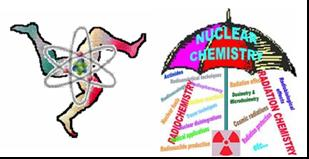Dr
Jozef Sabol
(Czech Technical University, Faculty of Biomedical Engineering)
23/09/2011, 08:30
Health Physics and Radiation Chemistry
oral presentation
The paper discusses the requirements for radiation protection in nuclear chemistry which are related to the recent recommendations of the International Commission on Radiological Protection. These recommendations are currently being incorporated into the International Basic Safety Standards to be issued by the International Atomic Energy Agency later this year as well as into new relevant...
Dr
Enrico Rizzio
(eni S.p.A. Exploration & Production Division)
23/09/2011, 08:50
Health Physics and Radiation Chemistry
oral presentation
Naturally occurring radionuclides are present at varying concentrations in the Earth’s crust and can be concentrated by processes associated with various industrial activities, such as the ones involved in the recovery of oil and gas. This “enhanced” NORM (Naturally Occurring Radioactive Material) are also known as TENORM (Technologically Enhanced NORM) and their presence in the upstream oil...
Dr
Shun Sekimoto
(Kyoto University), Mr
Yuichi Tanimoto
(Shimizu Corporation)
23/09/2011, 09:05
Health Physics and Radiation Chemistry
oral presentation
Europium and cobalt etc., contained in the biological shield concrete, are made a radiation with the neutron during the nuclear power plant and the accelerator facilities in operation. At the end of operation, biological shield concrete may be considered as radioactive wastes due to these radioactive nuclides. However, it is thought europium and cobalt content in the biological shield ...
Mr
Kevin Kelleher
(Radiological Protection Instiute of Ireland)
23/09/2011, 09:20
Health Physics and Radiation Chemistry
oral presentation
Since the early 1980’s the Radiological Protection Instiute of Ireland (RPII) has carried out extensive monitoring of the levels of anthropogenic radioactivity in the Irish marine environment through analysis of fish, shellfish, seaweed and sediment samples. The most significant source of this anthropogenic radioactivity arises from the liquid discharges from the Sellafield nuclear...
Prof.
Grazia Gambarini
(Università degli Studi di Milano and INFN, Milano, Italy)
23/09/2011, 09:35
Health Physics and Radiation Chemistry
oral presentation
In tissue exposed to high-flux epithermal neutron beams, the reactions mainly responsible for the absorbed dose in tissue are those with hydrogen and nitrogen, that is 1H(n,γ)2H (σ = 0.33 b), whose γ-rays of 2.2 MeV can travel many centimetres through tissue, and 14N(n,p)14C (σ = 1.81 b), whose emitted protons of about 0.6 MeV have short range in tissue, giving local dose deposition. The fast...
